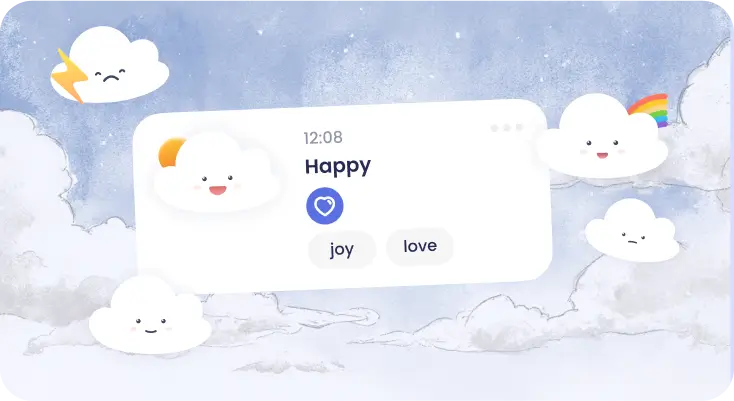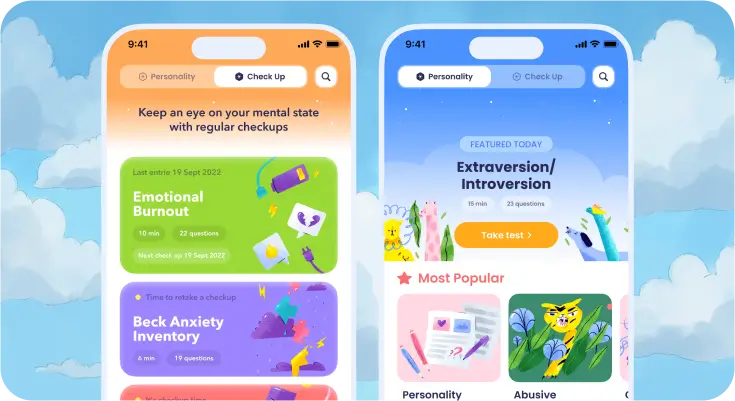Anxious attachment style means that you constantly crave closeness and worry that loved ones might leave you at any time. This fear might negatively influence your romantic relationships, friendships, and connections with family members.
Read the article to take a step toward fulfilling relationships. Whether you’re single or have a partner, check the tips to enhance your sense of security in communication with others.
What is the anxious attachment style?
Anxious attachment style is one of the insecure attachment styles characterized by a need for emotional closeness and constant reassurance, low self-esteem, and a fear of rejection.
People with anxious attachment don’t try to be needy on purpose. They might feel unsafe when there’s emotional distance or uncertainty, which can make them seek more reassurance. Deep down, they may worry that love is fragile and they need to “earn” it to avoid being abandoned.
Signs of anxious attachment style
- Fear of abandonment is a deep worry that people will suddenly stop loving you or caring about you. Even a slight change in tone can make a person with an insecure attachment worried.
- Low self-esteem causes feelings like “you’re too much” or “not enough.” Such people may believe that they need to put in extra effort to be good for others.
- Challenges in setting boundaries. Saying “no” can be especially challenging for people with an anxious attachment style. They might neglect their own needs not to push the other person away.
- Need for constant reassurance. “Was everything OK during the dinner?” or “Do you still love me?” If similar questions arise too often, it may signal that a person has a deep fear of rejection.
- Overanalyzing small details. People with anxious attachment may read too much into small things, like a shorter text or a delayed reply. They may assume something is wrong or that they did something wrong, even when there’s no real reason.
- Difficulty being alone means that a person feels empty when they’re without their partner or friends. Such people can become “the life of the party” and attend every gathering just to stay around others.
- Self-sabotage. Sometimes, a person with anxious attachment may create drama when things feel too quiet or distant. This is often an unconscious way to force a reaction from the other person to prove they still care.
Do you feel that some signs of anxious attachment style resonate to you?
How to handle attachment anxiety and develop a secure attachment style
While attachment styles tend to form in early childhood, this doesn’t mean they can’t be changed later in life. [1] As such, below we’ve collected the main tips to help you build secure relationships with friends, family members, or romantic partners.
1. Identify which of the four main attachment styles is yours
There are 4 main attachment styles that stem from the earliest childhood experiences.
- Secure attachment means that a person isn’t afraid to show affection, knows their emotional needs, can support their partner’s feelings, and is consistent in building fulfilling relationships. Someone with a secure attachment style also has a stable sense of self. They have a solid self-worth regardless of their relationship status.
- Anxious attachment means that a person worries about the relationship’s stability and needs constant reassurance that the partner won’t leave them. Those with an anxious attachment style worry about being abandoned and crave constant closeness.
- Avoidant attachment means that a person feels anxious about getting closer. They might downplay their feelings or prioritize independence to avoid vulnerability. They also worry about being abandoned, but they may default to abandoning others first to mitigate the risk of getting hurt.
- Anxious-avoidant attachment (disorganized, fearful attachment) is actually a mix of the previous two types. Relational dynamics can be unstable, as one day, a person can seek closeness, and the next day, push a partner away.
2. Acknowledge your patterns and emotional triggers
While attachment theory mostly talks about romantic relationships, attachment styles can also influence how you build friendships, address conflict situations, and connect with others.
To take a step toward a more secure attachment style, you need to understand what triggers the feeling of unsafety in relationships. Ask yourself the following questions:
- Do I get anxious when someone doesn’t reply to a message right away?
- Do I worry I’m “too much” when sharing my feelings?
- Do I keep trying to connect with someone, even if they don’t seem as interested?
- Do I feel extremely uneasy when things are stable in a relationship?
- Do I frequently seek reassurance to prove my worth or “goodness”?
You can also use Breeze’s mood tracker to explore how different situations impact your self-perception. Take notes, analyze patterns, and engage in deeper self-reflection.

3. Communicate openly about your emotions
Once you know the patterns that make you feel anxious, it may be reasonable to explain your feelings to your partner, friends, and family members. You may need to communicate that you feel worried when they:
- Don’t reply to your messages
- Get irritated
- Become withdrawn
- Seem upset
Your loved ones can express how they feel in such situations, and together, you will be able to limit the number of attachment triggers.
How can someone with attachment anxiety talk about their needs without overwhelming others or creating emotional pressure in the relationship? Nicole Arzt, LMFT, answers, “It’s important to talk to others in a regulated tone. This shows a sense of maturity and allows others to engage with you calmly. Remember that having needs does not make you needy. You’re allowed to ask for what you want and have preferences in a relationship, but others are also allowed the same.”
4. Build self-esteem from the inside out
Studies have shown that attachment issues can contribute to developing a negative self-image. [2] Nevertheless, it can work both ways, and having a low sense of self-worth may also reinforce insecure attachment patterns. To improve low self-esteem, you can:
- Set small goals and celebrate when you reach them.
- Create a “proof list” of your strengths and turn to it when you feel insecure.
- Surround yourself with people who reflect your worth. You can also spend more time with those who have secure attachment styles.
- Be kind to yourself, no matter what happens.
Explore other Breeze tests to find out whether your low self-esteem stems from childhood trauma and inconsistent caregiving or something that happened much later (like a toxic relationship). Knowing the root cause may help you understand what you’re healing from and discover the next steps.

5. Set healthy boundaries
Ask yourself, “What kind of behavior do I no longer want to tolerate?” You can create a list and convey your needs calmly but clearly. These can include the following:
- “I don’t accept mixed signals and want to build a connection based on open communication.”
- “I don’t want to rush physical closeness.”
- “I may need time for myself.”
- “I want my desires to be respected.”
If someone doesn’t respect healthy boundaries, it’s always OK to step back. Remember that protecting your peace doesn’t make you selfish.
6. Practice mindfulness
Mindfulness can help you focus on the present moment, reach greater self-awareness, and find new ways to regulate emotions. Here are some approaches that can make a real difference:
Progressive muscle relaxation
- Lie down comfortably on the floor and scan every part of your body.
- Notice whether some body parts are tense or in pain.
- Start with your feet. Tense the muscles, hold for 5 seconds, then release.
- Continue slowly moving above. Tense the muscles in your legs, stomach, chest, shoulders, and face.
- Take a few minutes to relax and let go of worries.
333 rule for anxiety
You can practice the 333 rule to self-regulate when you feel overwhelmed, no matter where you are:
- Look around and name 3 things you can see
- Name 3 things you can hear
- Move or touch 3 parts of your body
Journaling
Noticing your thoughts may be helpful as a quick way to overcome worries and a long-term approach to healing anxious attachment. With Breeze, you can notice your anxious thoughts or foster gratitude. The app provides comprehensive prompts that allow you to self-reflect on past relationship dynamics or list moments you felt loved.

7. Engage in activities that make you feel better
Positive affirmations
When people feel threatened (particularly in adult attachment), affirmations help them feel better by reminding them of what they value and what makes them feel good about themselves. [3] Save these or create your own list of positive affirmations that remind you of your value.
- “I am worthy of love and respect.”
- “My needs and feelings are important.”
- “I can set boundaries and still be loved.”
- “I deserve patience, understanding, and kindness.”
Deep breathing
Deep breathing can calm your nervous system and signal your brain that you’re not in danger, even if your emotions are intense. Try this:
- Inhale slowly through your nose for 4 seconds.
- Hold for 4 seconds.
- Exhale through your mouth for 6–8 seconds.
- Repeat this cycle a few times to feel a bit more grounded.
8. Challenge negative thoughts
An anxious attachment style may involve worrying about how others perceive you and whether they will leave you. When these thoughts feel tough to handle, it may be helpful to try this exercise.
- Recognize the thought. You can say it out loud or write it down. For instance, “I’m afraid my boyfriend doesn’t love me anymore.”
- Think about whether there’s any evidence of it. Don’t dwell on the thoughts, but rather on real facts. Maybe the person is just busy or dealing with a difficult day.
- Find proofs of safety. They might have sent a kind message earlier, made plans with you, or expressed care in a special way. These small moments can be easy to overlook for people who live with an anxious attachment style.
- Create a table that reframes the thought. Replace your beliefs with more gentle, realistic versions that reflect reality and work for your couple. It might look like this:
| Anxious thought | Reframed thought |
| “I believe they will leave me tomorrow.” | “I feel afraid of losing them, but there’s no real sign of that.” |
| “They didn’t text back, so something went wrong.” | “There can be many reasons for it. Maybe they’re just busy at work.” |
| “I’m too much, and they’ll get tired of me.” | “It’s OK to have emotional needs. The right person won’t see them as “too much.” |
Turn to this self-soothing technique anytime you feel worried about your relationships. It helps your brain learn that not every moment of distance is a threat and reminds you that thoughts are subjective.
9. Concentrate on yourself
People with anxious attachment might overly focus on how to keep closeness at any cost. But to reach true healing, you may need to shift focus from overthinking every phrase of your partner’s to your desires.
- Spend time alone and notice what actually makes you feel good.
- Find a new hobby.
- Write down your dreams.
- Regularly meet with your friends.
- Create a list of personal goals you want to achieve and work toward them.
Concentrating on yourself doesn’t mean that you no longer love your partner. Instead, it means that you’re building an adult relationship with yourself. When you feel more whole, you bring that wholeness to your commitments to others.
10. Work with a therapist
Some people might independently heal an anxious attachment style, but others may need professional help to make noticeable progress.
Attachment-focused therapy, emotionally focused therapy (EFT), and interpersonal therapy (IPT) are popular methods for working through anxious attachment. They help people understand their relationship patterns, manage emotions healthily, and improve communication skills.
Expert Insight
“Therapists often work to heal anxious attachment styles by exploring early attachment ruptures. It’s important to understand how the past affected you to better recognize your present-day struggles. Healing unresolved traumas can help you feel more anchored to yourself and connected to your relationship. Attachment work takes time, but it’s sincerely worth the effort.”
Nicole Arzt
Mental health professional
7 reasons why anxious attachment develops
Studies prove that anxious attachment style tends to develop as a result of early life experiences. [4] Let’s explore the emotional patterns that might lead to it.
1. Inconsistent parenting and uncovered emotional needs
One day, your parent might have been warm and present, and the next, they’re cold and distant. You start questioning, “What did I do wrong?” but this isn’t about you. As a result, you may learn that love is unpredictable and that closeness can disappear at any moment.
2. Early trauma or loss
Sudden changes like a messy divorce, the death of a primary caregiver, or a long stay in the hospital can create a “fear of the void.” It may create a feeling that building stable relationships is impossible and that anything can happen.
3. Child abuse or emotional neglect
If a kid experienced emotional abuse or parents didn’t pay attention to their emotions, this can create a feeling that they aren’t important and there’s a need to deserve love.
4. Conflicts between parents
Some kids whose parents have constantly fought in front of them were “peacekeepers” in their families. In adulthood, they may feel overly dependent on partners’ reactions and constantly try to avoid conflict.
5. Over-intrusive parenting
Another experience for an inner child that might have led to developing an anxious attachment style is when parents were too close. Kids who weren’t allowed to do anything on their own and had little personal space may grow up with challenges around being independent.
6. Parentification trauma
This happens when you needed to take care of your parents like an adult. If you spent your childhood worrying about how your parents felt or what was wrong with them, you learned that love is a job. You might still think that you have to be a great helper or someone who makes everyone happy.
7. Adult relationship trauma
Developing anxious attachment in adulthood is also possible. If you were in relationships that lacked mutual understanding or involved partner cheating or ghosting, it could have influenced your sense of safety in relationships.
Frequently asked questions
What are anxious attachment triggers?
These can be situations, phrases, and behaviors that provoke heightened anxiety among people with anxious attachment. Some of the following might include:
- Ignored messages
- Long replies
- Shorter texts
- Lack of physical affection
- Canceled dates (even because of an important reason)
- Changes in tone
- A partner’s need for some time alone
What is the difference between anxious attachment and disorganized attachment?
While anxious attachment is based on the fear of being left out or abandoned, disorganized attachment involves a mix of anxious and avoidant behaviors.
People who have anxious attachment tend to want to be close to others, need reinforcement all the time, and are very upset when they are emotionally distant. On the other hand, a person with disorganized attachment often struggles with a push-pull dynamic for closeness.
Sources
- Li, Yuxuan. (2023). “How does attachment style influence early childhood development?” Journal of Education, Humanities and Social Sciences
- Litvinenko, Irina. (2020). “Attachment Styles and Self-Esteem”
- Cascio CN, O’Donnell MB, Tinney FJ, Lieberman MD, Taylor SE, Strecher VJ, Falk EB. “Self-affirmation activates brain systems associated with self-related processing and reward and is reinforced by future orientation.” Soc Cogn Affect Neurosci. 2016
- Ramelan, Widyasari Bekti. (2025). “Tracing Anxious Attachment: How Past Experiences Shape Our Fear of Being Left Behind.”
Disclaimer
This article is for general informative and self-discovery purposes only. It should not replace expert guidance from professionals.
Any action you take in response to the information in this article, whether directly or indirectly, is solely your responsibility and is done at your own risk. Breeze content team and its mental health experts disclaim any liability, loss, or risk, personal, professional, or otherwise, which may result from the use and/or application of any content.
Always consult your doctor or other certified health practitioner with any medical questions or concerns
Breeze articles exclusively cite trusted sources, such as academic research institutions and medical associations, including research and studies from PubMed, ResearchGate, or similar databases. Examine our subject-matter editors and editorial process to see how we verify facts and maintain the accuracy, reliability, and trustworthiness of our material.
Was this article helpful?








